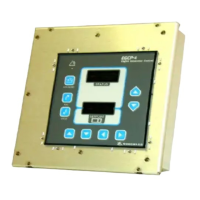EGCP-1 Engine Generator Control Package Manual 26059
84 Woodward
In order to give the end user of the EGCP-1 the ability to control engine run time
levels in a multiple unit system, any EGCP-1 in the system can be used to change
the network priority of any of the EGCP-1 units actively on the same network.
For a unit to be active on the network, it must have its Auto discrete input
closed, be configured for Multiple Unit operation, have its Auto Sequencing
setpoint Enabled, and be physically connected to the RS-485 network between
units.
The ability to change the priority of any unit on the network has some
fundamental rules associated with making changes to the unit priority. These
rules have to do with assuming a new master, changing the sequence of on load
units, and permissive sequence change states.
Assuming a New Master—All Units Off Load
When a unit’s priority is changed in such a manner as to make it the new master
on the system, the response of the system to the change of masters depends on
the operating state of the system at the time the change is made.
If the system is not on load and the engines are not running, and has not
experienced, or is not configured for a loss of mains condition, then switching
the priority of the master will have the following effect on the system:
After a maximum of 5 minutes, the Master indication in the Sequencing Status
screen will indicate the new master unit.
Shortly after this occurs, the new Master’s Sequencing Status screen will re-
order the Next On and Next Off slave units to fit the new system priority
configuration.
No units will start or go on load under these conditions as a result of the
assumption of the new master. See Figure 5-10.
MAINS
NETWORK ADDRESS #2
NETWORK PRIORITY #2
NO MAINS FAILURE DETECTED
ADDRESS: 1 2 3
OPER.
PRIORITY 1 2 3
MASTER 1
NEXT ON ALL
NEXT OFF
MASTER SEQUENCING SCREEN
NETWORK ADDRESS #1
NETWORK PRIORITY #1
G G
SYSTEM LOAD = 0%
NETWORK ADDRESS #3
NETWORK PRIORITY #3
G
ALL GENERATORS OFF LOAD
Figure 5-10. Original System Configuration

